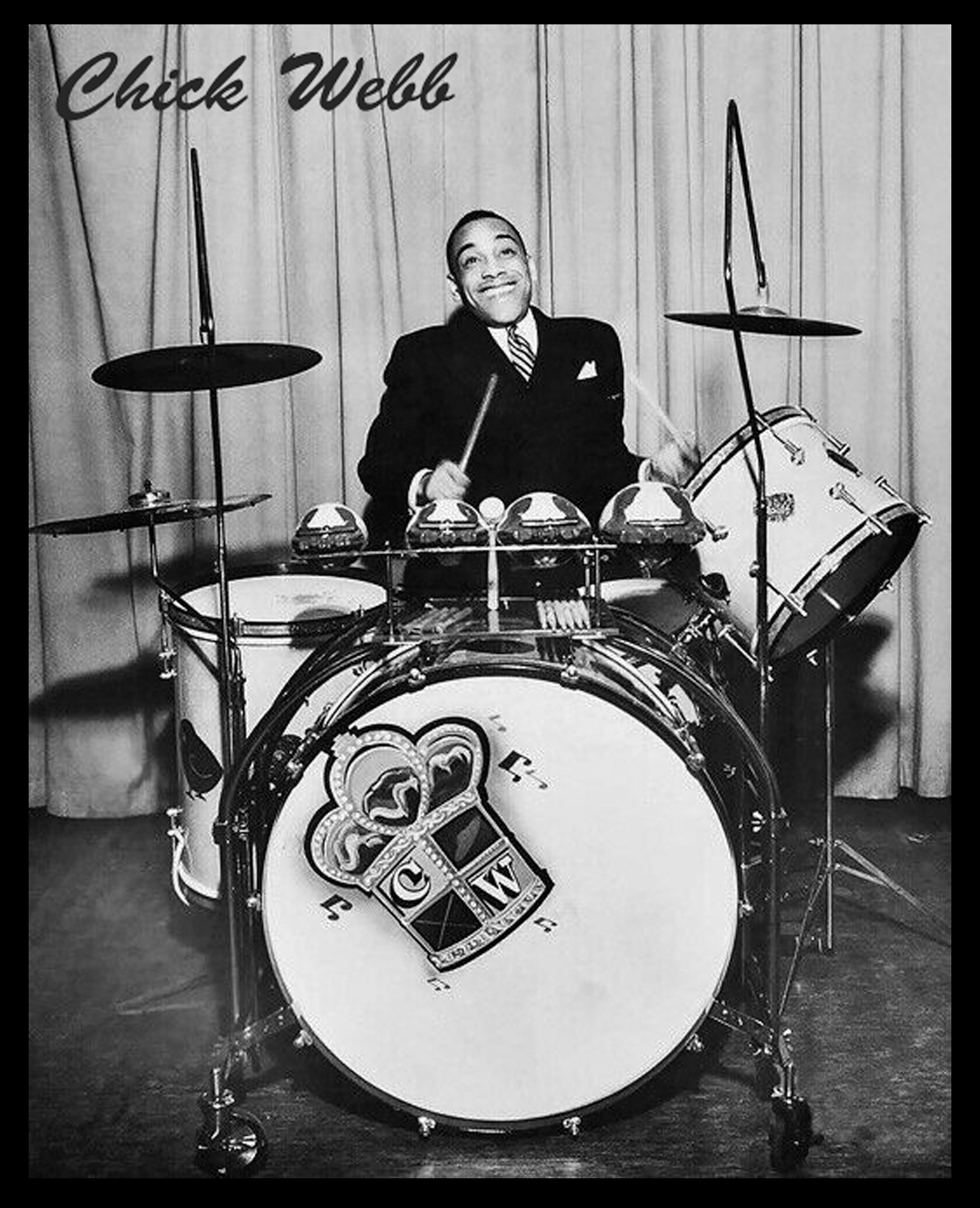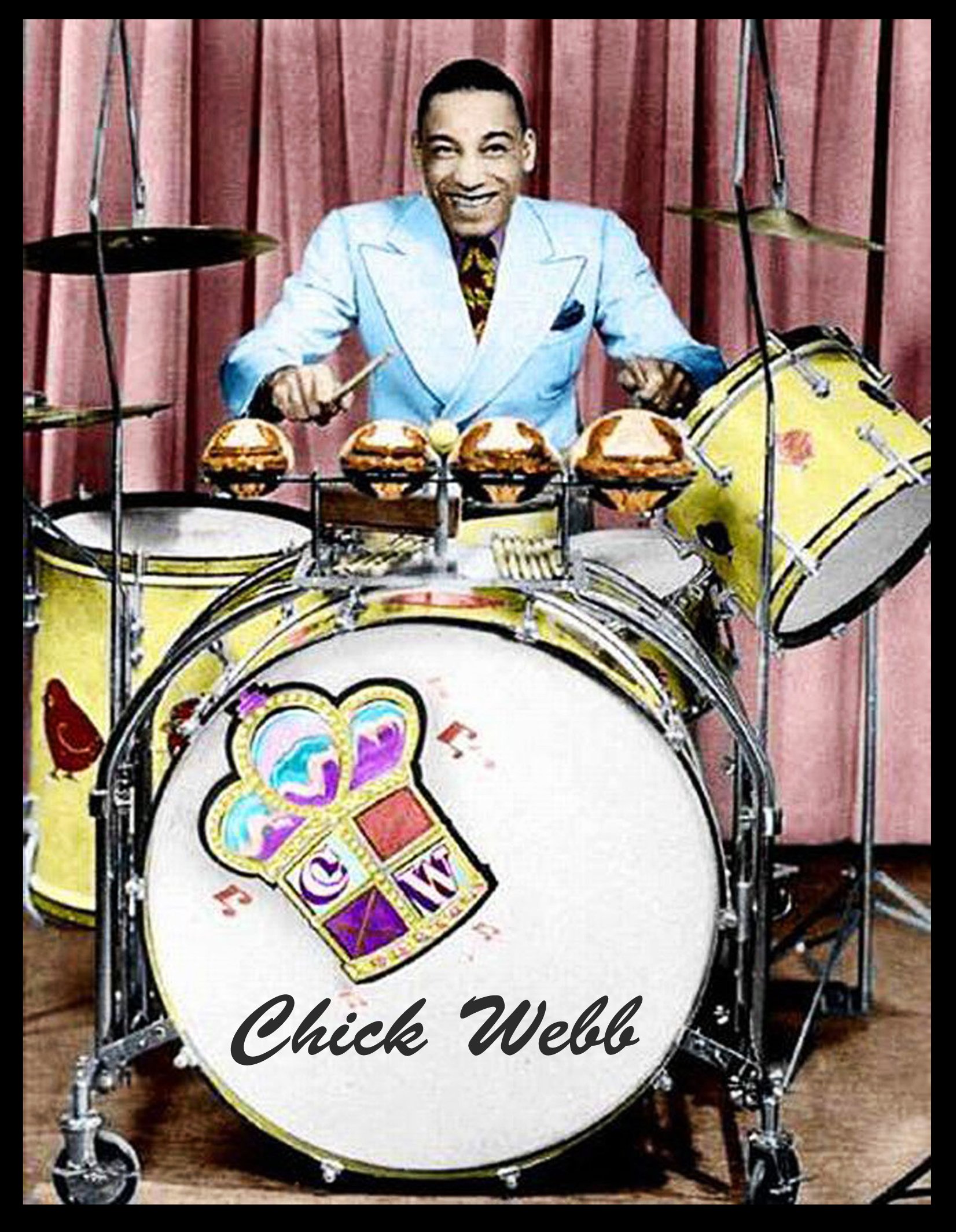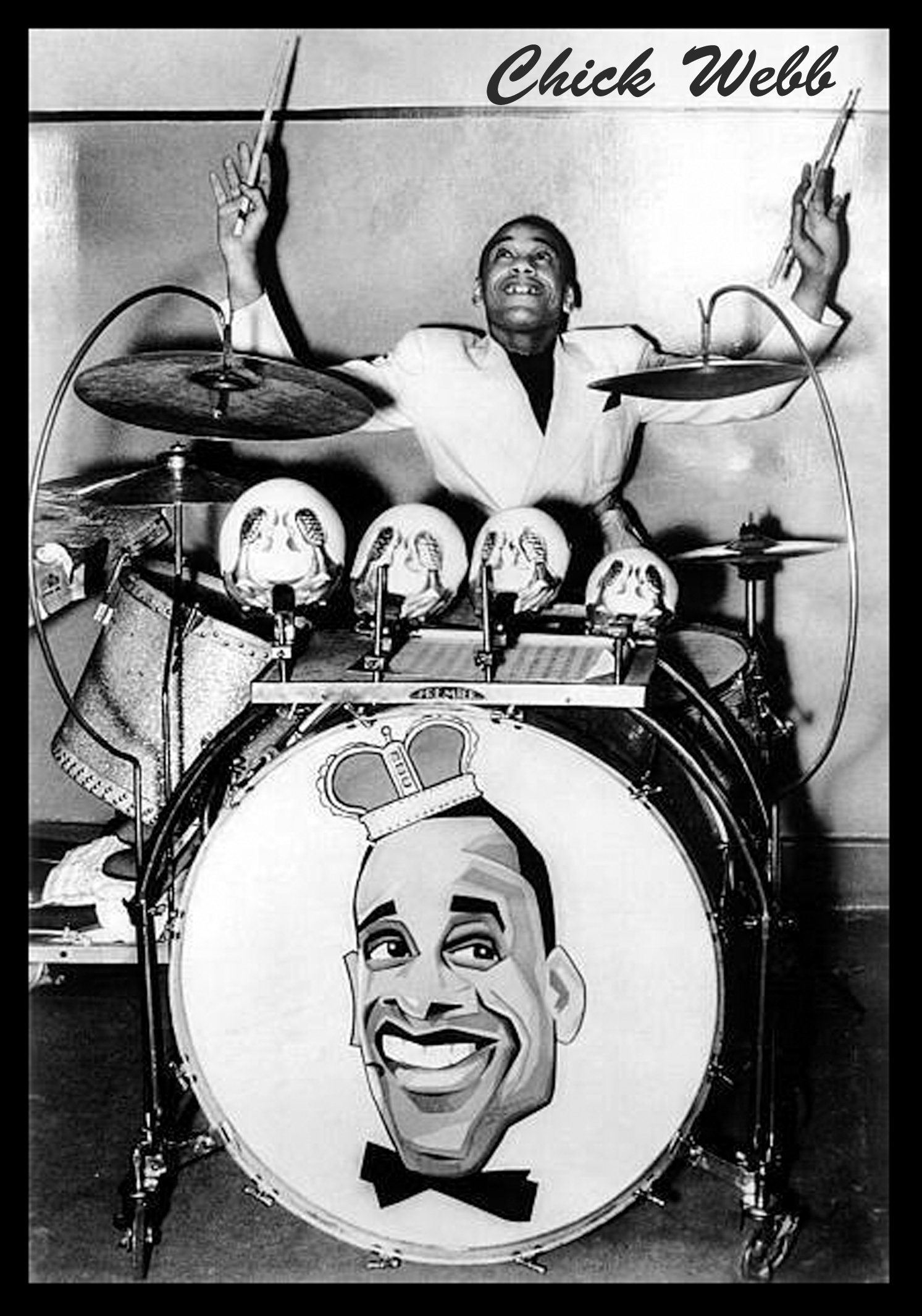“William Henry "Chick" Webb (1905-39) was one of the first virtuoso drummers in jazz and an innovative bandleader dubbed the "Savoy King," who reigned at Harlem's world-famous Savoy Ballroom. Along with the likes of Duke Ellington, Fletcher Henderson, and Cab Calloway, Webb helped create the popular dance and music culture, known as Swing, that swept the United States during and after the Great Depression and left an indelible impact on American culture. Having moved to Harlem from Baltimore during the Harlem Renaissance, Webb's creativity, charisma and persistence enabled him to navigate the harsh realities of racism and show business, lifting not only himself to stardom but also bringing other future legends-namely vocalist extraordinaire Ella Fitzgerald and R&B trailblazer Louis Jordan-along with him. But at the peak of his fame, at just 34 years of age, his life was cut short by the chronic spinal tuberculosis that had left him four feet tall with a hump on his back.” -Stephanie Crease (Rhythm Man)
I remember when I was about 18 years old, and I had just received a scholarship to The Juilliard School in New York City, and was admitted as the 1st African American Jazz Drummer to ever enter the Inaugural Juilliard Jazz Studies program under the direction of Wynton Marsalis and Victor Goines. There was a wonderful gentleman/trombonist named William “Bill” Pape that I used to work with in Jacksonville, Florida that was a Big Band player, and before I left for New York City, he gave me (2) pictures that he wanted me to have. The first picture was of Chick Webb sitting on the drumset with a regal and beautiful pose, and the second picture was with Chick Webb and his band featuring a young Ella Fitzgerald. The significance of these two photos and how they would correlate with my career and life evaded me until very recently; because they they indirectly served as a north star for what my career would become in the future.
Unfortunately in famed drum magazines and publications when the topic of jazz drumming is mentioned, they always speak about, Buddy Rich, Gene Krupa, Art Blakey, Max Roach, Philly Joe Jones, Roy Haynes, Elvin Jones, and Tony Williams; but they often forget the drummers that were very much part of the foundation of this music and art form. Drummers from the generation of Chick Webb that emerged in the early 20s literally played a hand in the evolution and innovation of the trap kit also know as the drum set.
In 2019, I was asked by famed jazz historian and the Artistic Director of the National Jazz Museum in Harlem Loren Schoenberg to participate in a lecture about the Great Chick Webb. Loren asked me to transcribe some of his drum solos that he played in the early to mid-1930s only to discover how forward thinking this gentleman was during that time as a player and soloist It’s important to note that Bebop Drumming had not truly been presented yet until the mid to late 1940s which created a freedom for jazz drummers to express themselves fully on the kit. Chick Webb was one of the first to create “solo drum breaks” and set the band up, which created the precedence for Big Band Drummers in the future.
At this same event at the Jazz Museum in Harlem, I was met by an incredible woman by the name of Stephanie Crease who had dedicated several years to diving through years of historical accounts to write a book about Chick Webb and his short life, but long-lasting impactful legacy. The conclusion of her work was published by Oxford University Press in a wonderful book titled, “Rhythm Man” and was just released last year. I asked Stephanie to share several key introductory facts with me for the purpose of this article, and for you to understand paramount aspects of Chick's musical and drumming contributions; for those that may not have an opportunity read “Rhythm Man.”
Stephanie and I have now collaborated on two lectures at New York City Performing Arts Library, Newark Public Library, and I am carrying the torch with her, assisting with educating the world about the great Chick Webb. My desire below is to highlight 8 key take-a-ways from the book, and urge the readers of “Not So Modern Drummer,” to purchase and share it with this next generation. I was told, if you never understand the beginning of a thing, your understanding of it’s present is never fully informed or realized.
Another key element that we forget is that the drummer is often the unofficial leader of any band because of the level of skill required to play our instrument, and have knowledge of everyone’s musical part, coupled with shaping the sound of a band and serving as the “engine.” Chick Webb was one of the early “Drummer/Bandleader Personalities, and created the template that was duplicated by many other famous drummers that would change the world.
8 Biographical Excerpts from “Rhythm Man”- Stephanie Crease
-William Henry “Chick” Webb, born in East Baltimore Feb 10, 1905, and grew up in a close extended family. Chick got his first drum set from his earnings as a newspaper boy. A childhood bout with spinal tuberculosis affected his height- he was only four feet tall- and a left him with spinal deformity. Neighborhood kids teasingly called him Chick, the name he would use professionally, but his family always called him William.
-As a young drummer Chick Webb played with popular dance bands in Baltimore theaters, clubs and on excursion boats in Chesapeake Bay. Pianist/ composer Eubie Blake’s breakthrough career in New York City in the early 1920s inspired young ambitious musicians like Chick to move to New York.
-Though Webb’s career is mostly associated with the Swing Era of the 1930s, he moved to Harlem in the mid-1920s, and right away got into the competitive jam session scene, which is where he befriended other young musicians like alto saxophonist Johnny Hodges. Together, they had an active rehearsal band. Duke Ellington, on the rise as a composer/bandleader, gave Chick his first bandleading job at a speakeasy in midtown.
-Chick’s early career as a bandleader had its ups and downs, his band, the Harlem Stompers, started competing in “Battles of Music” early on at the Savoy Ballroom, where he would come to fame as leader of the house band through most of the 1930s. Chick played or competed with almost every top bandleader of the late 1920s and on through the 1930s, including Louis Armstrong, Duke Ellington, Fletcher Henderson, Bennie Moten, Count Basie, Benny Goodman, and Tommy Dorsey.
-He was also a talent scout from early on; his early hires of musicians who became significant trendsetters themselves include Cootie Williams, Mario Bauza, Louis Jordan, and of course Ella Fitzgerald, whom he hired as an unknown young vocalist in March 1935.
-Chick brought the role of the drummer into the forefront as an important instrument, as the technology of drums and cymbals themselves improved. The renown Gretsch Company created special drums and whole sets for him, and fabricated an unusual “rack” console for him. (Editor’s note: Gretsch actually imported the wheeled rack from the Premier Drum Company in England). He was unique as a modern-thinking swing drummer bandleader who essentially “conducted” the band, shaping the arrangements from the drum throne.
He set the stage for the artistry of future drummer/ bandleaders like Max Roach, Kenny Clarke, Art Blakey, Buddy Rich, Gene Krupa, and others.
-In the late 1930s, as Chick’s band had more hit records and a huge radio following with Ella Fitzgerald, the band got non-stop invitations to perform and tour. They were among the first Black bands to play in several top-flight venues, including the Paramount Theater and Park Central Hotel in New York City, and many top theaters and ballrooms in the South and mid-west, often breaking through the color line.
-He died June 16, 1939, at John Hopkins Hospital, Baltimore, while his band with Ella Fitzgerald —at the peak of national fame— was in the middle of a long east coast tour.
It is my sincere hope that through this snapshot of an article, that you desire to dig in a little deeper and understand more about William Henry “Chick” Webb who was one of the early innovators and standard bearers of jazz drumming, and “The Beat that changed America.”



